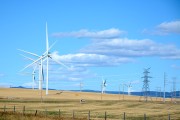This month, Ontario prudently decided that new nuclear reactors will not be part of the province’s forthcoming long-term energy plan. As Energy Minister Bob Chiarelli explained, “It is not wise to spend billions and billions of dollars on new nuclear when that power is not needed.”
That decision makes sense. Recent research published by the Pembina Institute and Greenpeace found that there is no need for new nuclear reactors to replace the output of the aging Pickering nuclear generating station. Forecasts we obtained from the Independent Electric System Operator suggest that Ontario’s demand for electricity 10 years from now will be pretty close to what it is today.
That said, the government still appears to be committed to refurbishing the 10 existing reactors at the Bruce and Darlington nuclear stations. That process is expected to begin with the Darlington reactors in 2016, and the Darlington project alone will take about eight years to complete (it’s more of a rebuild than a refurbishment, really).
Is that a wise investment?
No nuclear refurbishment project in Canada has ever been completed on time and on budget. Even if these refurbishments somehow bucked that trend, the most recent comparable refurbishment project — for the Gentilly-2 plant in Quebec — was abandoned when the estimated cost hit roughly 10 cents per kilowatt hour. At that price, it’s possible to deliver the same net result using a portfolio of energy efficiency and green energy technologies, which can be brought online more quickly and easily than refurbished reactors.
Nuclear refurbishment takes a long time — it is an incredibly complex and hazardous process. Referring to these projects as rebuilds instead of refurbishments would be more accurate, as the reconstruction of the Darlington and Bruce nuclear stations will take nearly as much time as building the reactors from scratch (eight years to refurbish compared to about 10 years for a new reactor). But once you’ve started, you are committed to the costs. You can’t half-build a reactor.
Nuclear refurbishment is also expensive. Ontario Power Generation has already awarded $1 billion worth of contracts just for pre-construction work on the Darlington project. According to OPG, this work must be completed before the project timeline and costs can be determined. Unfortunately, by the time that happens in 2015, OPG will have already signed the construction contracts for the project. Ontario will be locking into the Darlington nuclear rebuild, without ever having publicly reviewed the costs of the project or compared it with alternatives.
In any other context, that would seem unreasonable. Imagine if you were renovating your house, and a contractor asked you to hire him without a full price quote. Never mind that this particular contractor has never delivered on time or on budget in the past — the deal he’s offering forces you to commit without seeing the price tag. Why wouldn’t you shop around for a better deal, especially when a less risky and more cost-effective option is available?
For Ontario, that option is investing in a diversified portfolio of conservation and renewable energy technologies. The advantage of an efficient and renewable portfolio is simple: it can be built in smaller increments and in less time than nuclear reactors. And unlike nuclear, the deployment of renewable energy can be accelerated or decelerated in response to changes in Ontario’s electricity demand.
While the cost of rebuilding nuclear reactors continues to rise, the costs of renewable energy technologies keep falling. Moreover, the construction risks and cost overruns of renewable technologies are borne by investors rather than ratepayers. The same can’t be said for nuclear power: Ontarians are still paying off cost overruns from past nuclear projects through the Debt Retirement Charge on their monthly hydro bills, while waste disposal and liability costs are subsidized by various levels of government.
It’s good news that the government has decided not to build new nuclear capacity. But it’s still unwise to commit billions to rebuilding existing nuclear reactors without considering reasonable low-emissions alternatives. That is especially true when those alternatives are more flexible, more affordable and less risky than nuclear. Before we’re locked into an expensive contract, lets consider our options. It’s the wise thing to do.





